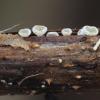
29-08-2025 19:04
Thomas FlammerSpores 21.2 - 26.2 x 8.3 - 11.3 µm - Q: 2.20 - 2.

29-08-2025 05:16
 Francois Guay
Francois Guay
I think I may have found the teleomorph of Dendros

28-08-2025 17:24
Thomas FlammerI know, that this is not the real topic of this fo

27-08-2025 12:02
Pavol PaloHello dear friendsI would like to ask for sharing

25-08-2025 17:37
 François Freléchoux
François Freléchoux
Bonjour,Nous avons trouvé samedi dernier à l'ét

20-08-2025 19:04
Ethan CrensonHello, This asco was found on the same wood as my
 Hello
HelloI have found this nice Lachnum on last years stem of Rubus idaeus. I firstly thought it was L. clavigerum, but it has a colour change - first yellow as seen on the photo later red-brownish. Also the spores are to big.
Sp. elipsoid-flattened elipsoid, 9-12 x 2-2,5. Asci approx. 55 x 4 µm without croziers, J+ (blue). Hairs cylindrical with warts/spines, some with crystals on the top. Paraphyses fusiform 3,5 µm broad
Cheers
Rasmus

Hello Rasmus,
in Lachnum you should first note 3 things:
- croziers (you did and say no)
- contents of living paraphyses (and hairs) - with or without a large amount of vacuolar guttules. I suggest: no
- crystals on the hairs. You do not mention then, so I think no.
L. clavigerum (as far as I have it in my mind correctly) has crystals on the hairs. I never found it on Rubus, but (as far as I remember) on Epilobium angustifolium.
The most common species on Rubus is L. virgineum - what do you think?
Best regards, Lothar

Thanks for the comments!
A lot of the hairs does in fact have crystals on the top. Also the colour change when bruised is quite distinct and not present in L. virginum as far as i know.
Best regards
Rasmus

I have a clavigerum folder for Rubus idaeus, with several samples (including HB 8585).
The spectrum of the species includes also Aruncus etc. I am not sure if there are any clear differences between the substrates, except for spore size:
9-11 x 2-2.5 on Rubus
6-9 x 1.7-2 on Epilobium/Aruncus
So perhaps two species?
Rasmus' description includes crystals. The colour change would point to VBs in the paraphyses and hairs, but for a species with crystals this is impossible. Actually, a yellowish-cream disc is not unusual in L. clavigerum.
Zotto

